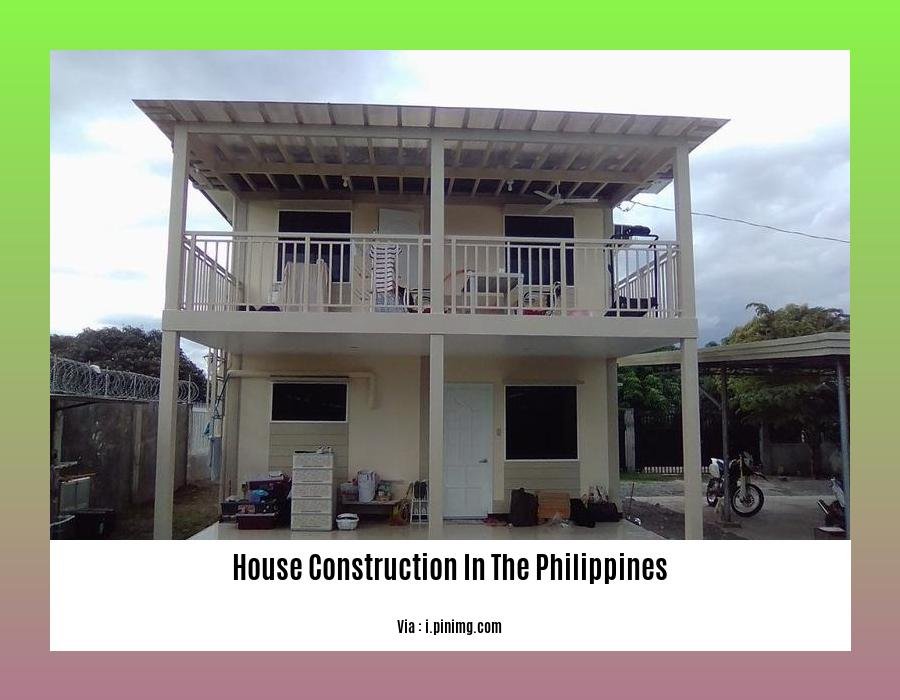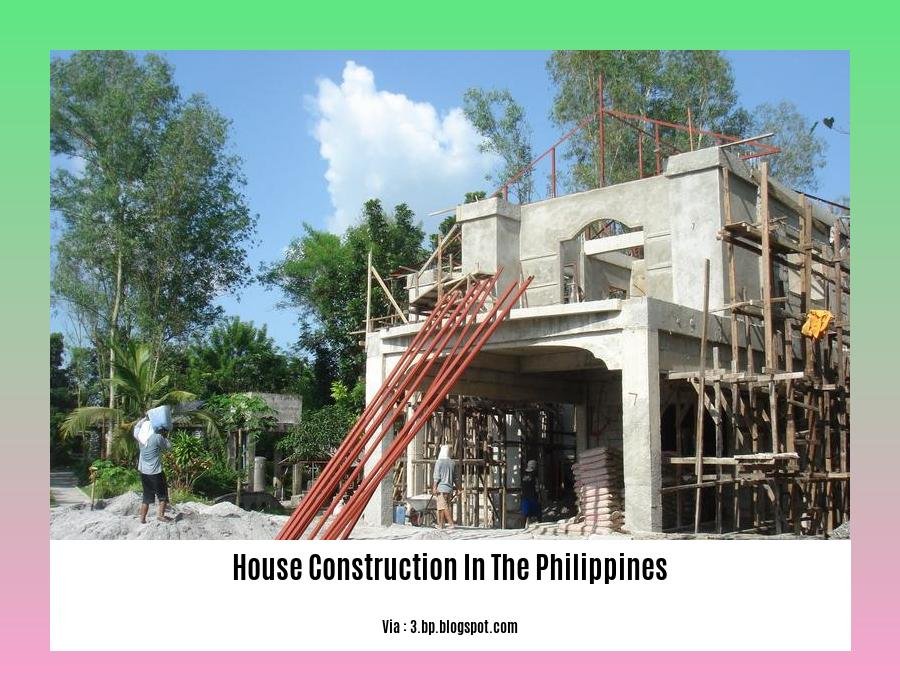Embark on a comprehensive journey into the realm of house construction in the Philippines with our expert guide. Discover the intricate details, challenges, and opportunities that sculpt this dynamic industry. From project management strategies to construction techniques and the intricacies of local regulations, we uncover the secrets to successful home building in the Philippines.
Key Takeaways:
- Cost to build a 100-square-meter house: P1.5 million to P4 million.
- Building from scratch allows for customization but is more expensive and takes more time.
- Required documents for construction: lot title, building permit, environmental compliance certificate.
- To reduce stress, consider hiring an architect and creating a detailed budget.
- Cost of construction per square meter in the Philippines (Q1 2022): 10,893.16.
House Construction in the Philippines

Navigating house construction in the Philippines can be daunting, but it’s a rewarding undertaking with careful planning. The costs can range from P1.5 million to P4 million for a 100 square meter house, depending on factors such as location, materials, and labor. While building from scratch offers customization, it requires patience and a higher budget compared to purchasing an existing home.
Essential documents for house construction in the Philippines include a lot title or plan, building permit, and environmental compliance certificate. To minimize stress, consider hiring an architect and setting a detailed budget. The construction cost per square meter in the Philippines was 10,893.16 as of Q1 2022.
Planning Tips
- Estimate costs: Factor in materials, labor, permits, and contingencies.
- Choose a location: Consider accessibility, neighborhood amenities, and development potential.
- Hire an architect: They can design your home and guide you through the construction process.
- Secure necessary permits: Obtain building permits from local authorities.
- Set a timeline: Establish a realistic schedule and stick to it as much as possible.
Construction Process
- Site preparation: Clear the land and prepare the foundation.
- Foundation: Construct the structure that will support the house.
- Framing: Build the framework of the house using wood or steel.
- Roofing: Install the roof system, including materials and drainage.
- Exterior finishes: Add siding, paint, or other exterior coverings.
- Interior finishes: Install drywall, flooring, and other interior elements.
- Electrical and plumbing: Install electrical wiring, outlets, and plumbing fixtures.
- Final touches: Add fixtures, appliances, and landscaping.
Maintenance Tips
- Regular inspections: Check for any signs of damage or wear and tear.
- Proper cleaning: Use appropriate cleaning methods for different surfaces.
- Preventive maintenance: Address minor issues promptly to prevent larger problems.
By following these steps and tips, you can successfully navigate house construction in the Philippines and build your dream home.
Dreaming of building your dream house in Ireland? Discover the costs involved and make your vision a reality!
For those yearning to create a home in the picturesque state of Kerala, explore house construction options to turn your dream into a tangible abode.
In the vibrant nation of Pakistan, the construction of a house holds cultural and practical significance. Learn about the intricacies and find your way to a home that reflects your unique style.
Finally, for those desiring to build in the mesmerizing island nation of Sri Lanka, delve into the world of house construction. Discover local practices and architectural wonders that will inspire your own home’s design.
Choosing Materials and Hiring Contractors

When building a house in the Philippines, the right materials and contractors can make all the difference. Here’s how to navigate these crucial aspects:
Materials: Striking the Balance
Choosing materials involves weighing quality, durability, and cost. Consider:
- Concrete Blocks vs. Timber: Concrete blocks offer durability and fire resistance, while timber provides natural warmth and flexibility.
- Natural Stone vs. Ceramic Tiles: Natural stone radiates opulence but can be pricier; ceramic tiles offer versatility, affordability, and easy cleaning.
- Wood flooring vs. Tiles: Wood flooring exudes warmth and elegance; tiles are durable, waterproof, and low-maintenance.
Hiring Contractors: A Matter of Expertise
Finding reputable contractors is paramount. Assess their:
- Credentials and Experience: Verify licenses, accreditations, and references to ensure competence and expertise.
- Communication Skills: Contractors who communicate effectively minimize misunderstandings and ensure a smooth construction process.
- Transparency and Fairness: Choose contractors who provide clear estimates, itemize costs, and adhere to agreed-upon timelines.
Step-by-Step Guide to Hiring Contractors
- Interview Multiple Contractors: Meet with several contractors to compare their proposals and choose the best fit.
- Check References: Contact previous clients to gather insights into the contractor’s work quality and professionalism.
- Formalize a Contract: Document the project scope, materials, timelines, and payment terms in a written contract.
- Establish Communication Channels: Set up regular meetings or communication channels for updates, decision-making, and issue resolution.
Key Takeaways:
- Consider quality, durability, and cost when selecting materials.
- Verify contractor credentials, experience, and communication skills.
- Establish clear contracts and communication channels for a smooth project.
Relevant URL Source:
- Navigating Construction: Essential Tips for Hiring House Contractors in the Philippines
Construction Process and Timeline
Construction, the journey from blueprint to dream home, is a delicate dance of planning, execution, and meticulous attention to detail. As a seasoned home builder, I’ve navigated this process countless times, and I’m here to guide you through its intricacies.
Key Takeaways:
- Meticulous planning: Imperative for a smooth construction journey.
- Experienced professionals: Architects, engineers, and contractors are your trusted allies.
- Clear communication: Key to ensuring everyone’s on the same page.
- Timeline: Realistic estimates set the pace for successful execution.
- Flexibility: Adapt to unforeseen circumstances while staying within your goals.
Construction Process: A Step-by-Step Guide
- Vision and Design:
- Envision your dream home and translate it into a blueprint.
-
Collaborate with architects and engineers to craft a design that meets your needs.
-
Site Preparation:
- Prepare the land for construction, including clearing vegetation, leveling the ground, and establishing drainage.
-
Ensure compliance with local building codes.
-
Foundation:
- Lay the groundwork for your home with a sturdy foundation.
-
Choose the appropriate type of foundation based on soil conditions and structural requirements.
-
Framing:
- Erect the framework that will support your home.
-
Use high-quality materials and follow industry standards to ensure durability.
-
Roofing:
- Protect your home from the elements with a reliable roofing system.
-
Consider factors such as weather conditions, material durability, and aesthetic appeal.
-
Exterior Finishes:
- Enhance your home’s appearance and protect it from the outside world.
-
Choose materials that complement your design and withstand the local climate.
-
Interior Finishes:
- Bring your home to life with interior finishes that reflect your style and comfort.
-
Explore options for flooring, walls, ceilings, and lighting.
-
MEP Installations:
- Equip your home with essential systems.
-
Install electrical wiring, plumbing fixtures, and heating/cooling mechanisms.
-
Final Touches:
- Complete your home with the finishing touches that make it truly your own.
- Add fixtures, appliances, and landscaping to create a welcoming and functional space.
Remember, the Construction Process and Timeline are inextricably linked. Set realistic timelines and monitor progress closely to ensure a successful completion of your dream home.
Citation:
Required Documents for House Construction in the Philippines
Legal and Regulatory Considerations
When embarking on a residential subdivision project in the Philippines, it is crucial to adhere to the following legal and regulatory requirements to ensure compliance and avoid potential setbacks:
Minimum Design Standards
Residential subdivisions must comply with the minimum design standards prescribed by the Philippine National Building Code (PBNC). These standards cover various aspects, including:
- Lot sizes and dimensions
- Building setbacks
- Road widths and grades
- Drainage and sewage systems
Local Government Units’ (LGU) Zoning Ordinances
LGUs have the authority to enact zoning ordinances that regulate land use and development within their jurisdictions. These ordinances may establish specific zoning districts with designated uses, such as residential, commercial, and industrial. Before proceeding with a residential subdivision project, it is essential to verify that the intended location conforms to the applicable zoning ordinance.
National Building Code Provisions
The PBNC sets forth mandatory building code requirements applicable to all construction projects in the Philippines. These requirements encompass:
- Structural safety
- Fire safety
- Sanitation and hygiene
- Accessibility for persons with disabilities
Failure to comply with these legal and regulatory requirements may result in delays, penalties, or even the refusal of building permits. It is highly advisable to consult with experienced professionals, such as architects and engineers, to ensure that your residential subdivision project meets all applicable standards and regulations.
Key Takeaways:
- Residential subdivision projects must conform to minimum design standards prescribed by the Philippine National Building Code (PBNC).
- LGUs have the authority to enact zoning ordinances that regulate land use and development within their jurisdictions.
- The PBNC sets forth mandatory building code requirements applicable to all construction projects in the Philippines.
Citation:
Presidential Decree No. 957 (PD 957): Revised Implementing Rules and Regulations
(2021)
FAQ
Q1: What is the estimated cost of building a 100-square meter house in the Philippines?
Q2: What are the crucial documents required for house construction in the Philippines?
Q3: What steps should I consider when planning to build a house from scratch?
Q4: How can I minimize stress during the home construction process?
Q5: What is the current cost of house construction per square meter in the Philippines?
- Dora the Explorer Wipe-Off Fun: Safe & Mess-Free Activities for Little Explorers - April 18, 2025
- Does Lemongrass Repel Mosquitoes? Fact vs. Fiction + How to Use It - April 18, 2025
- Do Woodchucks Climb Trees?Fact vs. Fiction - April 18, 2025










